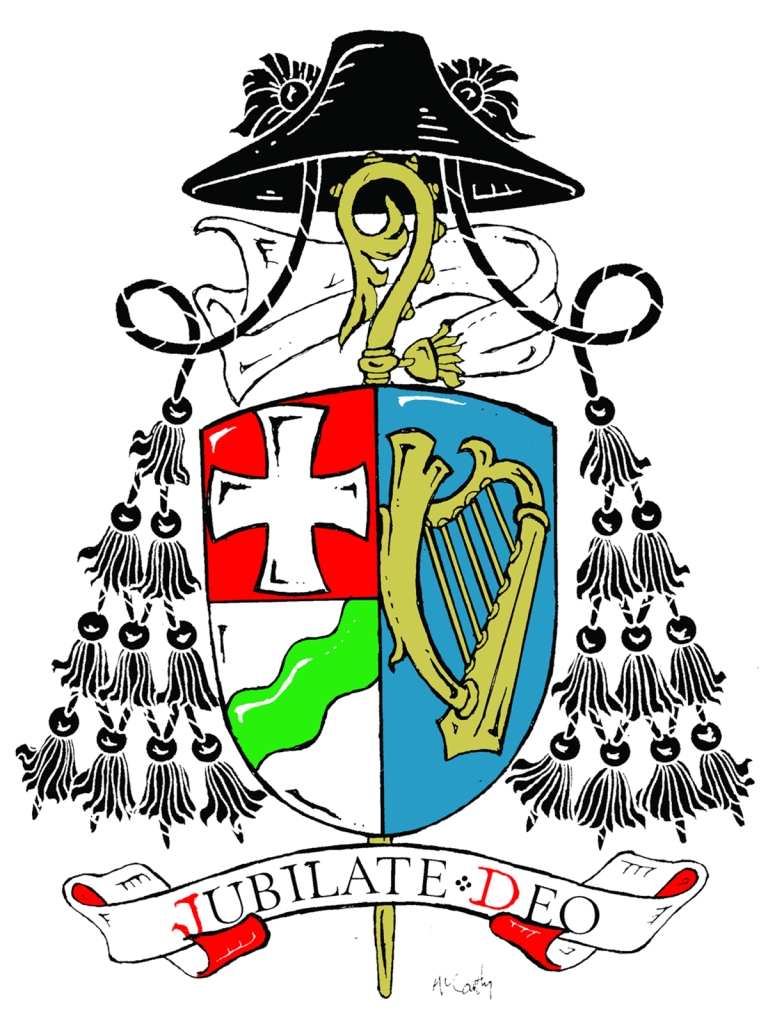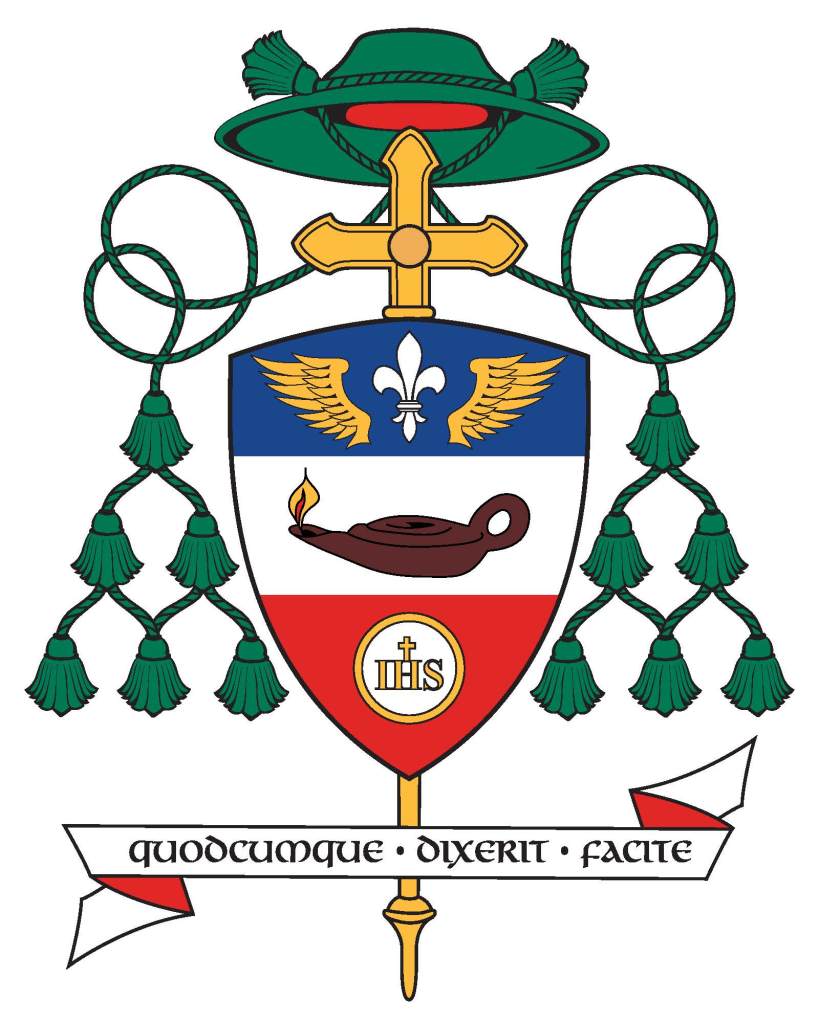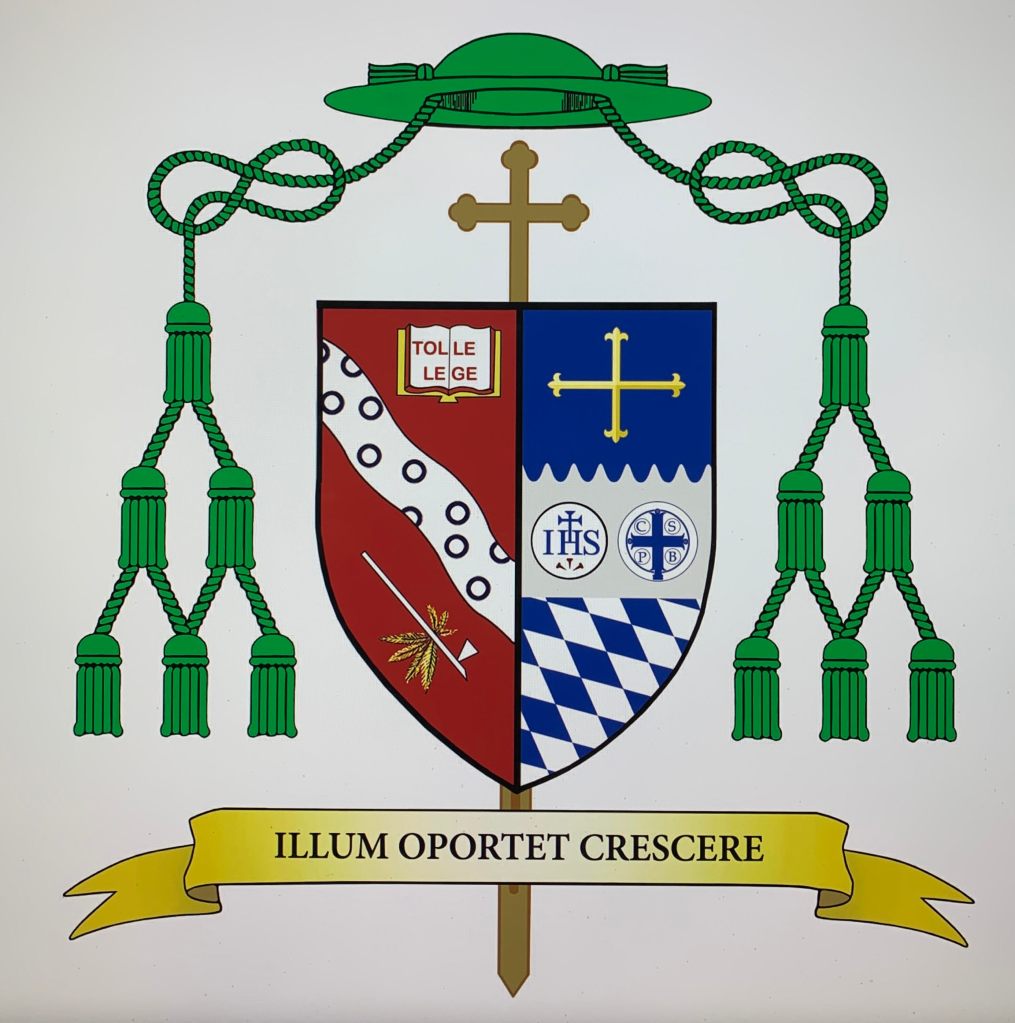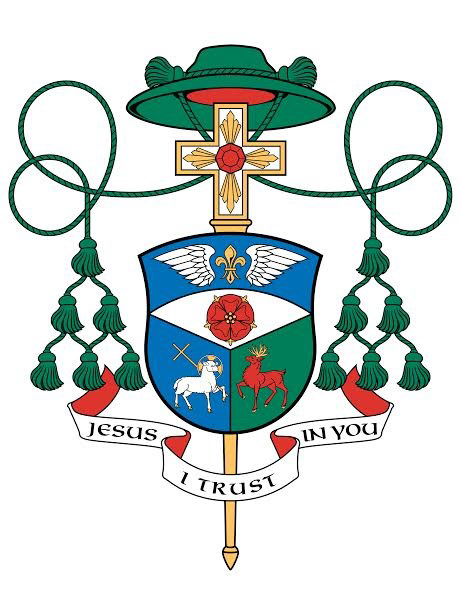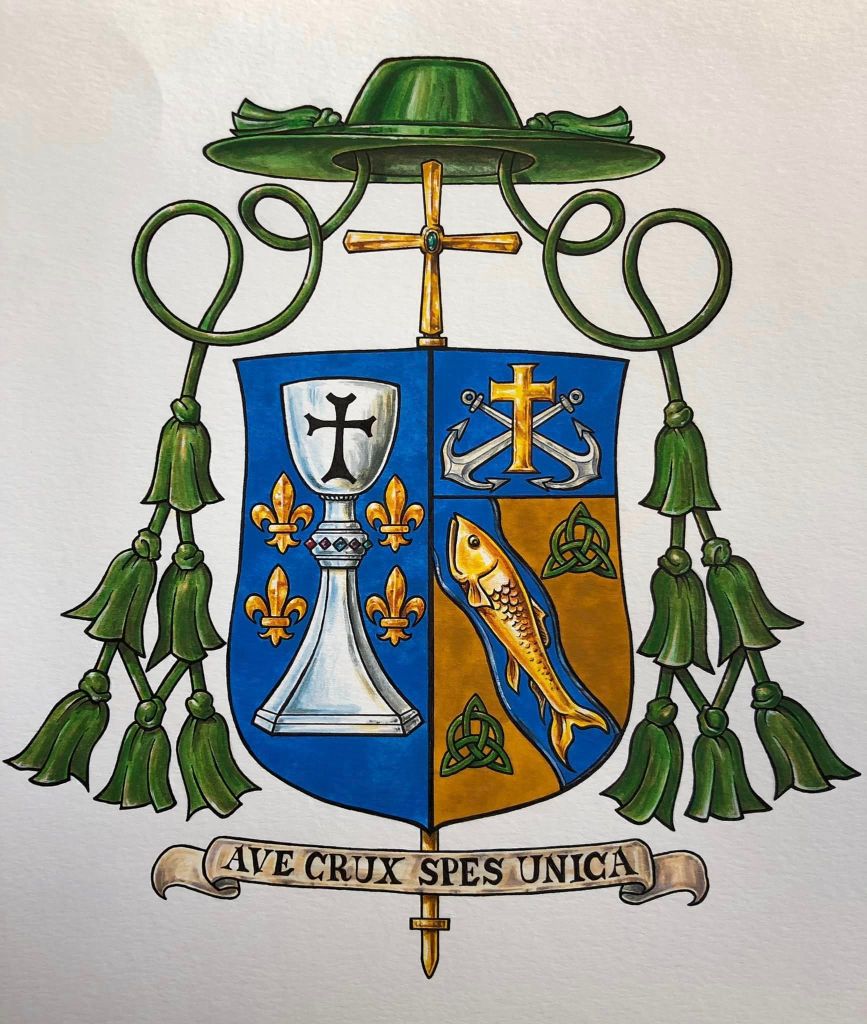On March 25 the Most Rev. Frank Leo (51) a priest of Montreal, Canada who has served there as an Auxiliary Bishop only since September of 2022, was installed as the 14th Metropolitan Archbishop of Toronto. His coat of arms is:
Quoting the website of the Archdiocese the achievement is explained as follows:
“Bishop Leo’s coat of arms is drawn from four principal aspects and devotions of his life and ministry, and is depicted on the shield in four quarters.
In the upper left (dexter chief) is found one of the most widespread Christological and Eucharistic symbols in Christian iconography: the pelican depicted opening its own flesh with its beak to feed its young with the blood that flows from it. This symbol refers to Christ himself as being the “Pie pellicane”, words found in the Adoro Te Devote, an ancient Eucharistic hymn attributed to Saint Thomas Aquinas: “Pie pellicane, Jesu Domine, me immundum munda tuo sanguine, cuius una stilla salvum facere totum mundum quit ab omni scelere” — “O loving Pelican, Jesus Lord, Unclean though I am, but cleanse me in your blood. One drop of which can free the entire world of all its sins.” It speaks of Christ shedding his own blood for all of humanity and how he continues to nourish us with his own flesh and blood in the Holy Mass. In the Gospel passage reported in. John 6:30, there is depicted a dialogue that took place in the synagogue at Capernaum. The Jews asked Jesus what sign he could perform so they might believe in him. They noted: “our ancestors ate manna in the desert.” Jesus replied that the real bread from heaven comes from the Father and it is himself, Jesus: “Truly, truly, I say to you, unless you eat the flesh of the Son of man and drink his blood, you have no life in you; he who eats my flesh and drinks my blood has eternal life, and I will raise him up at the last day. For my flesh is food indeed, and my blood is drink indeed. He who eats my flesh and drinks my blood abides in me, and I in him” (John 6:53-56). The Real Presence of Christ in the Eucharist as the One who nourishes us with his Sacred Body and Precious Blood is a fundamental doctrine of the Catholic faith.
A seven-point star is found on the upper right (sinister chief) and is the traditional and well-known Marian symbol par excellence. It refers to the invocation of the Virgin Mary as the Morning Star or “Stella matutina” found in the Litany of Loreto. The Morning Star is a sign of the coming day, preceding the rising sun. It is a promise of light, announcing the coming of the “sun of justice” (Malachi 4:1-3), the “daybreak from on high visiting us” (Luke 1:78). We know that the Blessed Mother is the Morning Star not for and through herself; she is indeed the reflection of God, her Creator and Redeemer. She exalts his glory and points to his light and salvation. According to Saint Bernard of Clairvaux, the great Troubadour of Mary, a star is a fitting comparison since it radiates light without losing its brightness, just as Our Lady, in giving birth to Christ did not lose her virginity. The symbolism of the star also refers to Our Lady as the Star of the Sea or “Stella Maris”, a title found in the medieval hymn Ave Maris Stella and whose praises are sung by the same Saint Bernard, famous for the invocation: Respice stellam, voca Mariam – Look upon the Star, call upon Mary. “If the winds of temptation arise; if you are driven upon the rocks of tribulation look to the star, call on Mary. If you are tossed upon the waves of pride, of ambition, of envy, of rivalry, look to the star, call on Mary. Should anger, or avarice, or fleshly desire violently assail the frail vessel of your soul, look at the star, call upon Mary.” Moreover, she is referred to as the Polar Star, or North Star, which navigators in antiquity looked to in seeking the right course so as to arrive safely to their destination. She is therefore our guiding light, our heavenly Mother, who is accompanies us as a loving companion on the journey of holiness in reaching Heaven, interceding for us. Finally, the Blessed Mother is also called the Star of the New Evangelization, which means she inspires and guides the Church’s apostolic efforts in bringing the Gospel to all peoples. The star is in silver (“argent”), a colour which depicts an array of heavenly attributes, personified in Our Lady’s purity, mercy and love. Bishop Leo entrusts his life, vocation and new pastoral ministry to her maternal mediation and intercession.
On the lower right (dexter base) is a boat floating on the waves and navigating amid the tempests. This is a well-known and clear reference to the Catholic Church established by Jesus Christ, the barque of Saint Peter. It is an ancient Christian symbol and reminds one of the struggles the Church endures, tossed about by raging winds, amid storms on the many rough seas of darkness and persecution but remaining set on its course and mission to bring to the harbour of salvation all of the travellers. Biblically, the imagery finds its origins in Noah’s ark in the deluge (Genesis and 1 Peter 3:20-21), and more clearly in the Gospel scene of Jesus protecting the boat of Saint Peter with him and the other apostles amid the stormy sea of Galilee (cf. Mark 4:35-41).
The depiction of a lion is found on the lower right (sinister base) and is meant to recall the Bishop’s surname, Leo, which is Latin for lion. The lion is depicted as rampant, meaning “on its hind legs”, with the head in profile. Biblically, the lion is a symbol of courage, power and strength, the victory of God (cf. Genesis 49:9-10; Revelation 4:7). The lion is the emblem of dignity, of a powerful and fearless ruler, of majesty and strong leadership. It is likewise an image of Christ, the King of Kings. The Messianic title, the Lion of Judah, is applied to Christ himself as we read in the Book of Revelation (5:5): “Do not weep. The lion of the tribe of Judah, the root of David, has triumphed.” Finally, there is an ancient belief that lion cubs were born dead and after three days were brought to life by their father’s roar. The lion is in red, the colour of blood and also of charity, a reminder of the ardent and infinite love of the Father who sent to us his Only Begotten Son and who shed his blood for our redemption and for the forgiveness of sins. It signifies also that the virtue of charity is key and an integral part for the pastoral zeal of the new Bishop, as a successor to the Twelve Apostles of Jesus Christ.
Blue is the colour symbolizing the incorruptibility of the heavenly vault, of the ideals that rise upward, and represents detachment from the earthly and passing, and the soul’s ascent toward God. The colour gold, the first among the “noble” metals (those resistant to corrosion), is symbolic of the first virtue: faith. For it is through faith that we can fully understand the love and salvation that the eternal and loving Father offers to all of us, his beloved children in Christ Jesus.”
(Designed and emblazoned by Renato Poletti)

